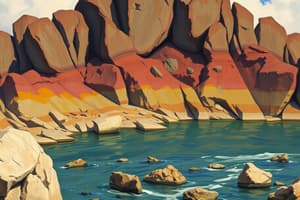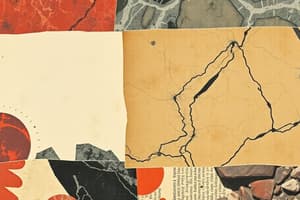Podcast
Questions and Answers
Who is the author of the Earth Science SLM?
Who is the author of the Earth Science SLM?
- Diosdado M. San Antonio
- Annabel A. Sengco (correct)
- Fe M. Ong-ongowan
- Marionel U. Briz
Which government department published this Earth Science module?
Which government department published this Earth Science module?
- Department of Interior and Local Government
- Department of Education (correct)
- Department of Science and Technology
- Department of Environmental and Natural Resources
What is the expected outcome from the carefully crafted activities in the SLM?
What is the expected outcome from the carefully crafted activities in the SLM?
- To facilitate understanding of each lesson (correct)
- To develop social skills through group work
- To improve memorization of facts
- To enhance test-taking skills
What is required to exploit the work published by the government for profit?
What is required to exploit the work published by the government for profit?
Which of the following best describes the content of the Earth Science module?
Which of the following best describes the content of the Earth Science module?
What is meant by 'borrowed materials' in the context of the module?
What is meant by 'borrowed materials' in the context of the module?
What is the primary basis for classifying rocks into igneous, sedimentary, or metamorphic types?
What is the primary basis for classifying rocks into igneous, sedimentary, or metamorphic types?
Which characteristics can be used to observe and classify rock samples?
Which characteristics can be used to observe and classify rock samples?
What is the location of the Department of Education's office mentioned in the module?
What is the location of the Department of Education's office mentioned in the module?
What process leads to the formation of igneous rocks?
What process leads to the formation of igneous rocks?
How can rocks be grouped when collected for observation?
How can rocks be grouped when collected for observation?
What are intrusive igneous rocks known for?
What are intrusive igneous rocks known for?
Which of the following does NOT categorize rocks?
Which of the following does NOT categorize rocks?
What is a defining feature of sedimentary rocks?
What is a defining feature of sedimentary rocks?
What would be an appropriate method for grouping rock samples observed for study?
What would be an appropriate method for grouping rock samples observed for study?
Which type of rock is formed through solidification or crystallization of molten materials?
Which type of rock is formed through solidification or crystallization of molten materials?
Which of the following rocks is an example of a clastic sedimentary rock?
Which of the following rocks is an example of a clastic sedimentary rock?
Which process primarily leads to the formation of metamorphic rocks?
Which process primarily leads to the formation of metamorphic rocks?
Which statement best describes intrusive igneous rocks?
Which statement best describes intrusive igneous rocks?
Chemical sedimentary rocks are primarily formed by which process?
Chemical sedimentary rocks are primarily formed by which process?
What characteristic distinguishes foliated metamorphic rocks from non-foliated ones?
What characteristic distinguishes foliated metamorphic rocks from non-foliated ones?
Which of the following classifications is NOT a way to group sedimentary rocks?
Which of the following classifications is NOT a way to group sedimentary rocks?
Which of the following is an example of a metamorphic rock that lacks foliation?
Which of the following is an example of a metamorphic rock that lacks foliation?
What type of rock forms from the solidification and cooling of magma or lava?
What type of rock forms from the solidification and cooling of magma or lava?
Which of the following is NOT a type of sedimentary rock?
Which of the following is NOT a type of sedimentary rock?
What distinguishes metamorphic rocks that are classified as non-foliated?
What distinguishes metamorphic rocks that are classified as non-foliated?
Heat and pressure most significantly affect the formation of which type of rock?
Heat and pressure most significantly affect the formation of which type of rock?
Which process is primarily responsible for the creation of clastic sedimentary rocks?
Which process is primarily responsible for the creation of clastic sedimentary rocks?
Which of the following is a characteristic of foliated metamorphic rocks?
Which of the following is a characteristic of foliated metamorphic rocks?
Which material precipitates from solution to contribute to sedimentary rock formation?
Which material precipitates from solution to contribute to sedimentary rock formation?
What is the primary component of organic sedimentary rocks?
What is the primary component of organic sedimentary rocks?
What is the primary process through which intrusive igneous rocks are formed?
What is the primary process through which intrusive igneous rocks are formed?
Which of the following is an example of extrusive igneous rock?
Which of the following is an example of extrusive igneous rock?
Which category of sedimentary rock is formed from the mechanical weathering debris of other rocks?
Which category of sedimentary rock is formed from the mechanical weathering debris of other rocks?
What differentiates chemical sedimentary rocks from other types?
What differentiates chemical sedimentary rocks from other types?
Which of the following rocks is primarily formed through the process of crystallization of magma?
Which of the following rocks is primarily formed through the process of crystallization of magma?
What characteristic of some extrusive igneous rocks can result from rapid cooling?
What characteristic of some extrusive igneous rocks can result from rapid cooling?
Which type of sedimentary rock is formed primarily from the accumulation of organic material?
Which type of sedimentary rock is formed primarily from the accumulation of organic material?
What is a common feature of vesicular extrusive igneous rocks?
What is a common feature of vesicular extrusive igneous rocks?
Flashcards are hidden until you start studying
Study Notes
Classification of Rocks
-
Rocks are classified based on their formation processes and composition into three main categories: Igneous, Sedimentary, and Metamorphic.
-
Igneous Rocks: Formed from the cooling and solidification of magma or lava.
- Intrusive Igneous Rocks: Solidify below the Earth's surface, characterized by large mineral crystals. Examples: Granite, Diorite, Gabbro.
- Extrusive Igneous Rocks: Formed on the surface, often glassy or vesicular. Examples: Obsidian, Pumice, Basalt.
-
Sedimentary Rocks: Formed by the deposition and cementation of mineral or organic particles.
- Clastic Sedimentary Rocks: Comprised of debris from weathered rocks. Examples: Sandstone, Siltstone.
- Chemical Sedimentary Rocks: Created from dissolved materials precipitating from solution. Examples: Rock salt, Chert.
- Organic Sedimentary Rocks: Formed from the remains of plants and animals.
-
Metamorphic Rocks: Produced from existing rocks (igneous, sedimentary, or pre-existing metamorphic rocks) undergoing heat and pressure.
- Can be classified as Foliated (with banding) and Non-Foliated (without banding). Examples: Gneiss (foliated), Marble (non-foliated).
Key Concepts and Characteristics
- Rocks are defined as naturally occurring solids made up of minerals and possibly non-mineral particles.
- Classification is done based on physical properties (color, hardness, texture) and chemical composition.
- Factors influencing rock formation include environmental conditions, presence of minerals, and biological processes.
Activities and Learning Methodology
- Engage students with practical activities, such as collecting and categorizing rock samples using observational skills.
- Encourage critical thinking through questions about grouping criteria and identifying common characteristics of rocks.
- Provide opportunities to reinforce knowledge through fill-in-the-blank exercises and classification tasks.
Summary of Key Terms
- Igneous Rock: Formed from magma/lava solidification.
- Sedimentary Rock: Created through deposition and cementation.
- Metamorphic Rock: Transformed by heat and pressure.
- Foliated: Metamorphic rock with visible layering.
- Non-Foliated: Metamorphic rock without layering.
- Clastic: Sedimentary rock formed from weathered debris.
- Chemical Sedimentary Rock: Result of material precipitation.
- Organic Sedimentary Rock: Contains biological debris.
Studying That Suits You
Use AI to generate personalized quizzes and flashcards to suit your learning preferences.




